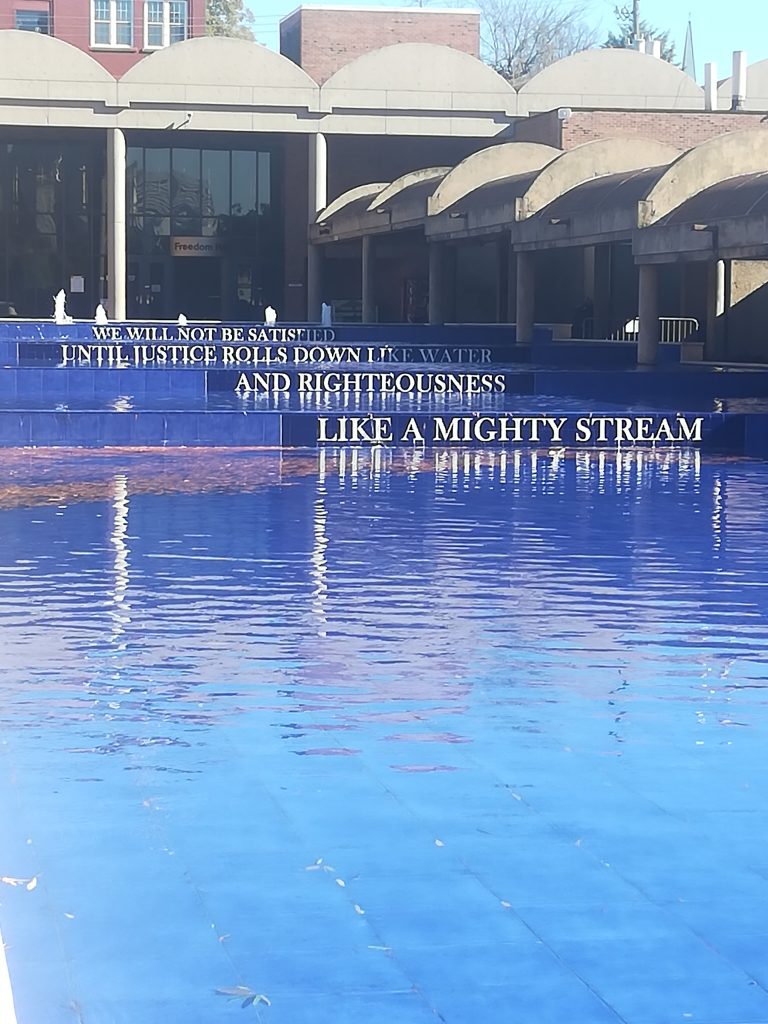Blog by: Carter Nevil ’24, Alex Rotaru ’22 and Elijah Weddington ’22

The first thing we saw as we came into Atlanta were the skyscrapers, going on for miles and miles. None of the cities we stopped in were built quite so tall. Thankfully, upon arrival, we were able to explore the city a little bit. Alex and Carter went to Centennial Park and walked around the Georgia State University campus after getting there using the MARTA. The city at dusk and during the blue hour on the tree-lined narrow streets, contrasting with the lights of the skyscrapers across I-85 were just gorgeous, though the strong winds among the tall buildings brought about biting cold as the sun came down.
Shortly thereafter, our first stop in Atlanta was at the Actor’s Express, a theater company, where we watched a theatrical performance called “Hometown Boy.” “Hometown Boy” followed alongside the modern take on the sub-genre called Southern Gothic, that draws attention to societal issues. This sub-genre was used to illustrate multiple themes that are putative to messages of being a “deeply flawed, disturbing, or eccentric” narratives. From an analysis perspective, the play challenges categorical norms. And plays into multiple categories — making the play comedic, suspenseful, and grotesque. After the performance, we were given the opportunity to speak to the artistic director to pick his brain on how the play was constructed. He pointed out the obvious themes of the play then encouraged us to dive deeper into what we thought the play was trying to achieve in regards to intersectionality and the dualism of multiple individuals. The play follows the life of an Asian American family, tacking issues of duality, mental illness, sexual trauma, and social class. Overall, we believed “Hometown Boy” was a great play to attend, and brought attention to how theatre can be used to inform accounts from the past in present day scenarios, that touch on disturbing narratives.
The next day, we took a tour of the city of Atlanta. Our tour guides, Omar and Satchel, mainly focused on the Civil Rights Movement but also included information about movies produced in the city and more. For example, we saw one of Tyler Perry’s film studios, the house where the Madea movies were filmed, and buildings that were seen in multiple Marvel superhero movies.
On the Civil Rights side of the tour, we stopped and saw the last residential home of Rev. Dr. Martin Luther King Jr. This was very stunning to see, because it looked just like every other house next to it. Another place of interest that we visited was Ebenezer Baptist Church. This church was where King would be the co-pastor and serve until he was assassinated. The last stop on the tour was to the Martin Luther King Jr. National Historic Site, where King and his wife, Coretta Scott King, are buried. It was very powerful to see the eternal flame and his quotes all around the site, telling you about his life and the difficult pursuit of nonviolence.
Our final stop for the day was the National Center for Civil and Human Rights, which had three exhibits: one on Rev. Dr. King’s speeches, one on the Civil Rights Movement from Brown v. Board (1954) to Rev. Dr. King’s assassination (1968), and one on Human Rights.

The latter really piqued our interest, as it helped contextualize the Civil Rights Movement into the wider human rights movements and violations going across the globe — from immigrant’s rights in the US, to genocide prevention in Rwanda, to the tragedies caused by autocratic regimes like the ones in Nazi Germany, Soviet Russia, Cambodia, Chile, and Maoist China. The exhibit goes to show just how many injustices there are in the world, and how the Civil Rights Movement can provide valuable lessons that can be applied elsewhere in the world where similar situations occur. In many ways, the exhibit is also a reminder that civil rights activists’ work is not yet complete, and that we, too, should follow in their footsteps and help overcome the injustices we see in the world around us.
Speaking of which, the Dr. King exhibit also showcased moments where the Civil Rights Movement intersected with other movements, such as the Gay and Lesbian Rights Movement after the Stonewall Riots (1969) and the iSi Se Puede! Movement to better the lives of immigrant grape and cabbage farmers in California; in fact, the iSi Se Puede! Movement organized a march to Sacramento, similar to that from Selma to Montgomery.
In many ways, our stop in Atlanta provided context and showcased opportunities for what we, in the present, can do to further the goals of the Civil Rights leaders in our own communities, and how the struggle for equality transcends race, economic status, gender identity, sexual orientation, and more. This was also an opportunity to see how Black excellence and an incredible multicultural scene emerged in the city where, in 1915, the Ku Klux Klan burned their first cross, atop Stone Mountain.